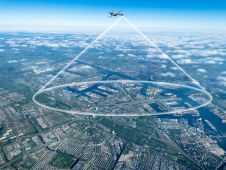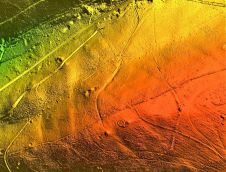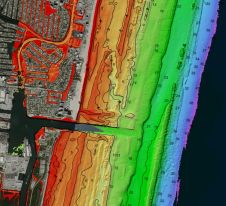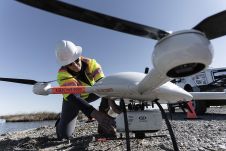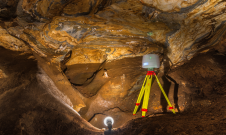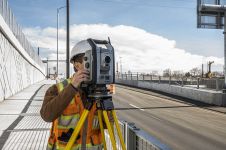结合水文和无人机摄影测量湖湖批量计算
用船和无人机创建卷计算的3D模型
What is the best way to generate a high-precision 3D model to estimate the storage capacity of a lake that is surrounded by mountains? Rapid weather changes, low clouds and steep mountainsides demand a sensible approach with the right equipment. This article provides insights into the surveying process of a lake mapping project including the methods used to create a 3D model for the generation of a precise map with elevation lines.
(By Benjamin Federmann, Benjamin Busse and Kim Schlüter, Germany)
Situated at 848 metres above sea level in the Swiss Alps, created by an ancient rockslide and flanked by the 2,900m-high Glärnisch mountain massif (Figure 1), the Klöntalersee lake is a stunning attraction for tourists and artists alike due its ravishing beauty. But poets and painters are not the only ones to have recognised the potential of the 3.3km2lake, which is fed by the surrounding mountain brooks like the Klön. In 1908 a dam was constructed on the eastern side of the Klöntalersee, between Rhodannberg and Sackberg, to generate electricity for homes and businesses in the surrounding area. Thanks to the bulk earth dam, which today is 220 metres long and 21.5 metres high, the lake can hold approximately 39.8 million cubic metres of water, which can be used to generate electricity during times of demand peaks or fluctuations.
在一种方法组合水文和摄影测量中,Ingenieurteam Geo船员计划使用他们的探测器调查该地区Surveyor, the industrial unmanned aerial vehicle (UAV)aibot x6(Figure 2) as well as positioning technology from Leica Geosystems to generate a 3D model for accurate and centimetre-precision calculation and simulation of the actual holding capacity.
Multibeam echosounder
毕竟筹备措施,批准程序和规划步骤已经完成,专家与其声纳装备的船只一起旅行Surveyor在Klöntalersee映射湖泊的普通水表。拥有172个计划的录音线,六米长的船只帆船使用其Teledyne Reson Seabat 8101 Multibeam Echosounder创建湖泊土壤的详细信息。挡倒盘以150度的角度发射声信号,并通过测量回声的经过时间来计算水的深度。每秒301个频率为101梁,水文照片通过每秒3,030个单点的晶粒接收高精度数据。在每个测量轨道中的三分之一重叠,专家在测量期间达到了比十厘米更好的精度。但在收集数据之前,必须精确地校准测量系统,以避免干扰因素并正确确定结果。
Adjusting the sensors
That entailed adjusting the sensor technology before every deployment to subtract both linear movements of the vessel as well as rotation around its axles to impede any errors. A further step for the hydrographers to obtain a clear and detailed view of the lake bottom was to factor the water’s sound velocity into the calculation. The sound velocity changes depending on temperature and suspended particles and becomes especially important in lentic water.
After the boat had been launched and calibrated, the crew put out to sea on a 2.5-hour initial cruise to get a first impression of the lake’s character and began to create the first sonar data of the soil. Following their planned routes and taking the lake’s depth and texture into account, the hydrographers on theSurveyorcollected enough information to create a point cloud containing almost 135 million XYZ coordinates. All in all, the crew on the observation boat succeeded in recording all 2,855,204 square metres of the Klöntalersee in just five days.
Not only rapidly changing weather conditions and bone-chilling cold pushed man and machine to their limits, but the glaciated Glärnisch massif forming the lake’s southern shore quite literally cast a 2,900-metre shadow and put the technology to the test. With the massif’s steep slopes in such close proximity to the water’s edge, the experts feared they might lose their GPS stream due to signal opacity on the south side of the Klöntalersee. In that case, tachymeters placed on the northern and eastern shores of the lake would have determined the boat’s position. However, because of the lake’s elongated kidney-like shape, that would have caused serious problems in obtaining accurate details about the boat’s position.
稳定的定位
By using the Leica Viva GS 16 GNSS antenna on theSurveyor使用Multibeam Sonar记录的数据可以以厘米精确分配给坐标。由于内置SmartLink技术,机组人员仍然能够录制高精度数据并接收GNSS校正数据,即使GSM网络信号丢失。由于550个频道,最先进的测量引擎和超现代化的RTK算法,可以使用测试结果精确分配来自AIBOT X6 UAV和船只的数据。
海岸的空中测量
Shore situations are hard to capture for multibeam-equipped vessels due to their general design. In addition to that, the risk of damaging the sensitive and expensive sensor rapidly rises in shallow water and in proximity to the shore. In order to obtain exact results for the volume calculations and simulations in spite of this, the engineers drew on their experience with the UAV and decided to capture the shores and embankments via airborne photogrammetry.
After the lake was measured at regular water level from the boat, the engineers began to plan the flights of the UAV. To capture the shore regions overlapping with the measurements taken by the boat, it was crucial to fly the UAV at lower water levels. Once the level of the Klöntalersee had lowered seasonally, the survey with the hexacopter could begin.
To record the often angled and steep terrain of the bank area as precisely as possible, the experts decided to survey each area several times to increase the validity of their data. After the flight planning on the PC had been completed and the waypoints had been loaded onto the UAV’s internal storage device, the ground control points (GCPs) around the lake were captured using the GNSS receiver so the first flights could begin.
具有挑战性的条件
Once again, the surveying of the alpine reservoir presented its very own challenges for man and machine. In addition to average below-freezing temperatures, rapid weather changes and low clouds, the southern bank of the Klöntalersee with its steeply sloping mountain walls once again posed the biggest challenge. The UAV had to take off from and land on a separate boat because the steep walls and the dense vegetation along the shoreline made it impossible for the pilot to operate from the land. In addition to the sensitive and reliable technology, the pilot’s skills and steady hand were particularly important.
Despite the adverse conditions, the team from Karlsruhe was able to collect highly precise data in 18 flights, so the dry shore strip with a total length of over 12 kilometres was covered within two days. With a picture taken every two seconds and the drone moving with 4m/s, the experts ensured that the data was recorded with the highest accuracy by the camera attached to the flying multisensor platform.
As with the recordings of the surveying boat, it was of the utmost importance for the UAV-based results to be accurately referenced. For this purpose, the Ingenieurteam GEO experts used the Aibot HP GNSS 2 RTK/GNSS module (L1/L2) and the Leica GNSS receiver. This proved to be a good combination for working under such difficult conditions to achieve an accuracy of 1-3cm in georeferencing the collected data.
后处理数据
After all the measurements had been performed, the surveying experts began to process the obtained data. The point clouds created by the multibeam sonar had to be fed into the PDS 2000 bearing software to manually edit and correct them for errors. In order to integrate the shoreline data into the volume calculation, all 4,400 high-resolution images from the UAV had to be imported into Aibotix AiProFlight where they were merged with the coordinates from the UAV’s log file. After that, the georeferenced data was edited in the AgiSoft PhotoScan Pro post-processing software to create a three-dimensional model as well as a point cloud. Subsequently, the two 3D models were combined in the Autodesk application AutoCAD Civil 3D to generate an exact model of the lake (Figure 3).
Reliable 3D models
使用来自3D模型的数据,工程师生成了一个精确的地图,具有客户端的高程线。工程师加到了盘子上,找到了完成工作的正确工具,结合了两个完全不同的调查方式来调查大型和具有挑战性的地区,以产生精确的结果。通过船舶和无人机生成的数据,专家能够满足客户的需求,无论他们想要详细的虚拟3D模型还是包括轮廓线的印刷计划。
Biographies of the authors
Benjamin Federmann在斯图加特研究了商业经济学,并于2015年以来,德国无人机制造商Aibotix GmbH营销,通讯和产品管理总监。
Benjamin Busse是一支基于Karlsruhe的Ingenieur队Geo Geo Engineering Office的UAV飞行员和专家。
Kim Schlüter, who is studying politics and has written articles for German public-service broadcasting, joined Aibotix GmbH in 2016.















